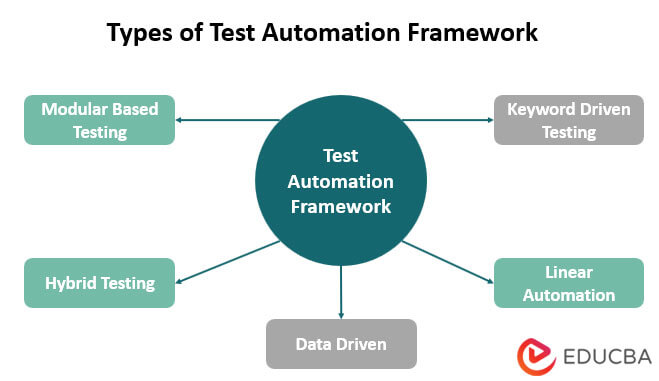Updated April 17, 2023

What is Test Automation Framework?
Test Automation Framework is a set of tools used to establish rules and guidelines for developing test cases by test professionals. These rules may include coding standards, test data handling, storing test results, and other resources. The framework aids in developing test scripts and recording them. There are different types of automation frameworks available to test applications based on various platforms such as mobile, desktop, and web-based applications running on different operating systems such as Windows, Mac OS, etc.
The Test Automation Framework is used to execute test cases and compare the output with user requirements or output. The testing framework is always independent and easy to expand, maintain and use. It reduces the effort and time required to test the same thing repeatedly. It also describes which part of the application is being implemented, helps to find problems at an earlier stage, and is easier to resolve as soon as possible. The test framework is mainly responsible for defining the format to express expectations, executing tests, and reporting results.
Features of Test Automation Framework
Test Automation Framework has several benefits, some of which are as follows:
- Reduces the cost and lowers risks
- Improves test efficiency
- Lowers the cost of maintenance
- Maximizes test coverage and functionality of the application
- Defines the reusability of code
- Avoids duplication of test cases used for automation across platforms
- Automates testing of independent applications
- Organizes test suites and enhances test efficiency
Types of Test Automation Framework
The following are the common types of frameworks:

1. Modular-Based Testing Framework
This framework is built on the concept of abstraction. The creation of independent scripts represents the modules of the application under test into separate units, functions, and sections. It allows making script changes to specific modules without affecting others. It takes less effort to create test cases, as they can be reused for other modules as well.
2. Data-Driven Framework
This framework stores input and expected output results in separate files or data sources like CSV files or spreadsheets. It enables executing multiple test cases with various data sets quickly. Furthermore, it requires less amount of code to generate the test cases.
3. Keyword Driven Testing Framework
It is the framework that utilizes the data tables and keywords to perform on the application under test. The test data and directives are used to develop the test scripts, and these directives are called keywords, which developers reuse as multiple test cases. It is extensive data-driven testing.
4. Linear Automation Framework
It is used as a recording and playback framework. The script developer does not require to write the code in sequential order for functions and methods. It records the navigation process and uses that script to test the functionality.
5. Hybrid Testing Framework
This framework combines the modular, data-driven, and keyword drove testing frameworks. It helps data-driven scripts to take advantage of libraries and integrates the advantages of all other frameworks.
Advantages and Disadvantages of Test Automation Framework
Advantages:
- Saves time and effort in testing
- The fastest way to test applications
- Scaling and maintenance are easy
- Allows easy execution of multiple datasets
- Avoids hard-coded data
- Allows building test scripts independently of the platform and applications under test
- Helps in writing lightweight and easy-to-understand test scripts
- High code reusability
Disadvantages:
- Scripts developed using a particular framework may not be reusable for other frameworks.
- Maintenance of the application requires a lot of rework, and sometimes modules are not scalable.
- Hardcoding data in test scripts may limit the ability to use multiple datasets for testing applications.
- Testers need programming knowledge to write test scripts in the automation framework.
- Developing test scripts can take longer than expected, exceeding deadlines.
- Setting up the framework can be initially costly, time-consuming, and complex.
- Individuals should have good knowledge of frameworks.
- Test automation may not always work in the tester’s favor due to complex data or scenarios.
Conclusion
Test Automation Framework is a popular tool for testing applications based on different programming languages and platforms. The testing framework saves a lot of effort and time to test the application on a frequent basis. When selecting a framework, factors such as application independence, ease of expansion and maintenance, and resource availability should be considered. There are different types of frameworks to choose from, which can be open source or licensed, and the selection should be based on specific requirements and budget.
Recommended Articles
Here are some further related articles for expanding understanding:

